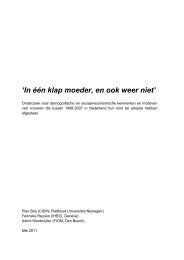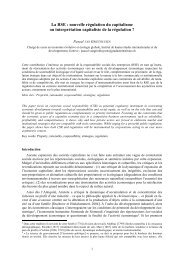PDF - Graduate Institute of International and Development Studies
PDF - Graduate Institute of International and Development Studies
PDF - Graduate Institute of International and Development Studies
You also want an ePaper? Increase the reach of your titles
YUMPU automatically turns print PDFs into web optimized ePapers that Google loves.
1.1.1. Demographic changes<br />
The first <strong>and</strong> most important cause is the rapid increase in the numbers <strong>and</strong> purchasing<br />
power <strong>of</strong> the urban population. The national population in all Gulf countries increases<br />
relatively rapidly by international st<strong>and</strong>ards, although the rate <strong>of</strong> growth has been<br />
declining in recent years. National population growth is reinforced by the continuous<br />
inflow <strong>of</strong> expatriate workers. Internal population movements have led to increasing<br />
concentration in urban areas, <strong>and</strong> a portion at least <strong>of</strong> the population has enjoyed<br />
significant improvement in living st<strong>and</strong>ards, leading to an increase in the size <strong>of</strong> the<br />
average dwelling, universal reliance on ambient air conditioning, <strong>and</strong> very widespread<br />
use <strong>of</strong> household appliances.<br />
The effect <strong>of</strong> some <strong>of</strong> these phenomena may become less important in the future –<br />
national population growth is slowing down, <strong>and</strong> the process <strong>of</strong> urbanization is almost<br />
complete – but others may continue to be felt for quite some time; in particular there are<br />
still numerous nationals <strong>and</strong> expatriates living in less than optimal conditions, whose<br />
energy consumption patterns are waiting to evolve towards significantly higher levels.<br />
1.1.2. Industrialization<br />
The second important cause is the process <strong>of</strong> economic diversification, <strong>and</strong> the<br />
concentration on energy-intensive industries.<br />
Here one should distinguish industries that use oil <strong>and</strong>/or natural gas as feedstock<br />
(petroleum refining, petrochemicals) <strong>and</strong> industries that use the same as sources <strong>of</strong> heat<br />
(again, petroleum refining <strong>and</strong> petrochemicals, but also cement, iron <strong>and</strong> steel, building<br />
materials, glass, etc.). Although some <strong>of</strong> these activities are important consumers <strong>of</strong><br />
electricity in addition to heat, they also <strong>of</strong>fer the opportunity <strong>of</strong> recovering waste heat on<br />
a much larger scale bigger than is done already, <strong>and</strong> use the same to produce electricity<br />
more efficiently. Combined heat <strong>and</strong> power (CHP) <strong>of</strong>fers significant potential for the<br />
improved efficiency <strong>of</strong> energy use. Water desalination, which is an absolute necessity in<br />
the arid climate <strong>and</strong> a prerequisite for the survival <strong>of</strong> all urban centres in the region, is<br />
now normally combined with power generation <strong>and</strong> may thus be viewed as contributing<br />
more to the supply <strong>of</strong> electricity than to its dem<strong>and</strong>. 1<br />
1 Desalination plants in the GCC are predominantly the multi-stage flash type (MSF), which generate heat<br />
that can be recovered to produce electricity. Where reverse osmosis (RO) technology is used, the plant<br />
absorbs electricity <strong>and</strong> contributes to dem<strong>and</strong>.<br />
5




